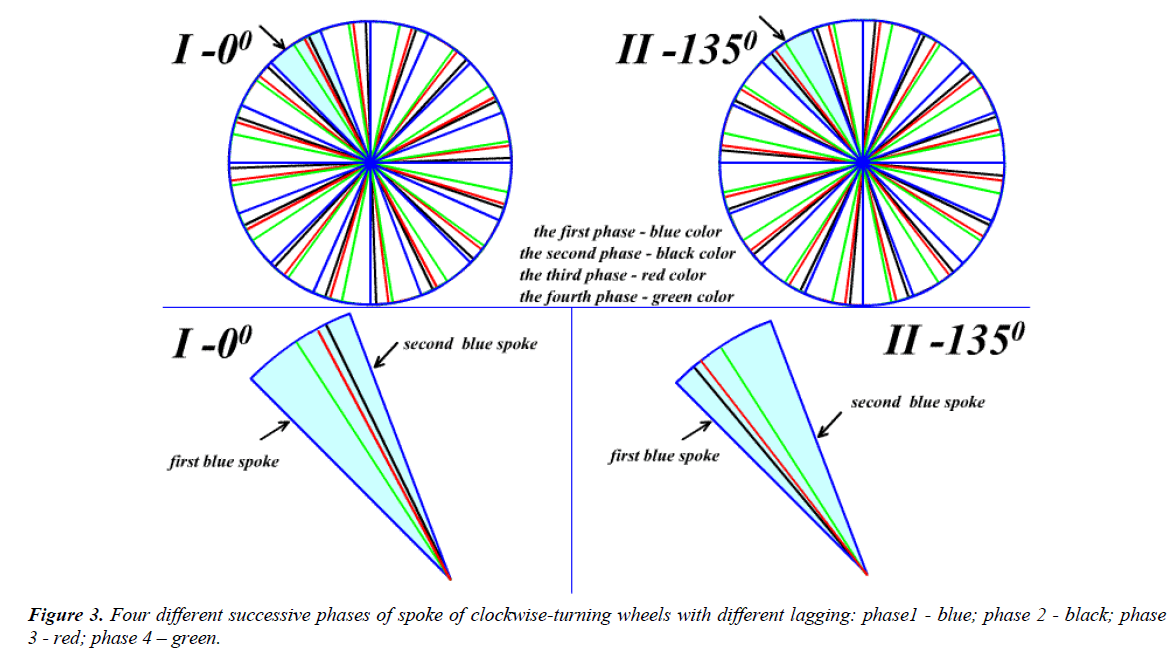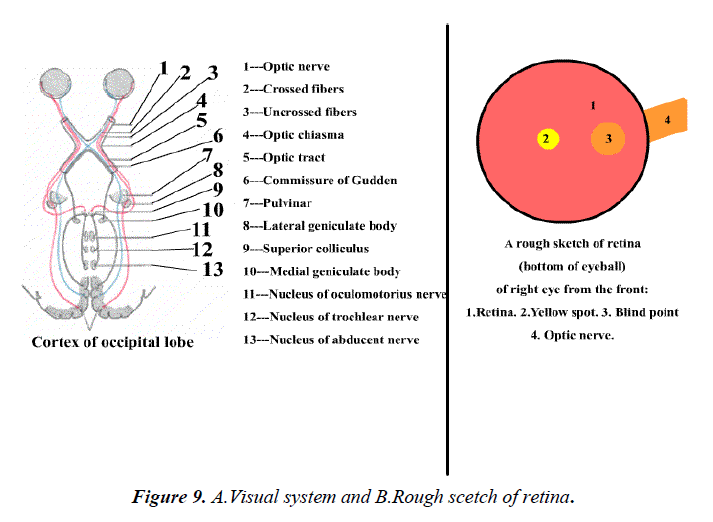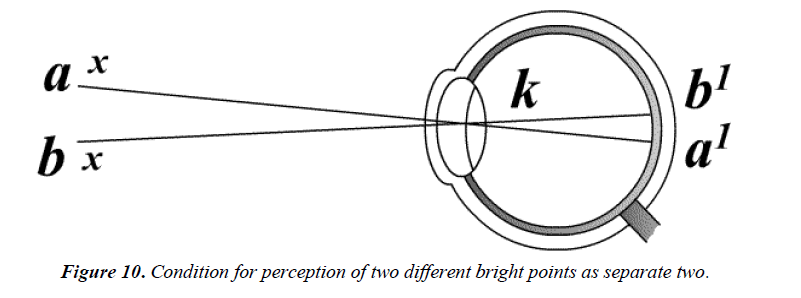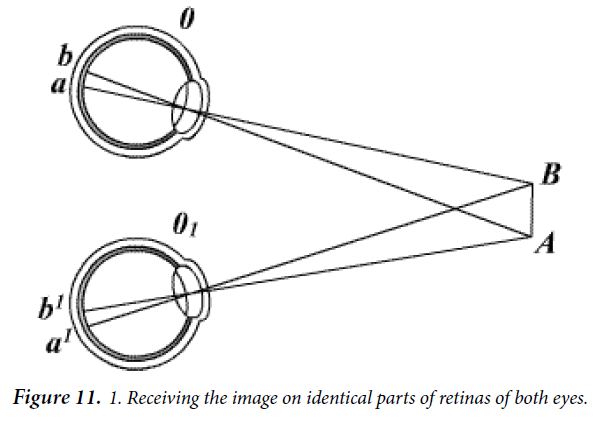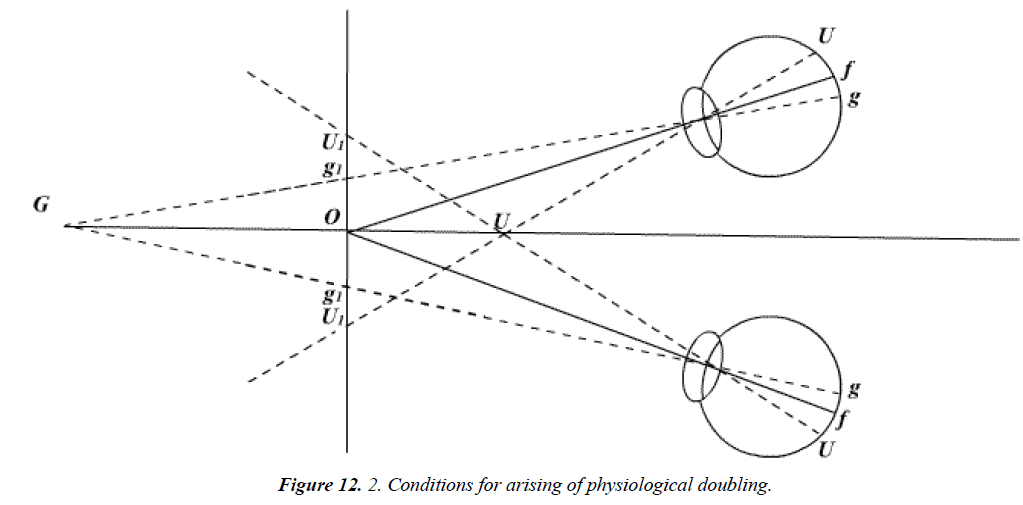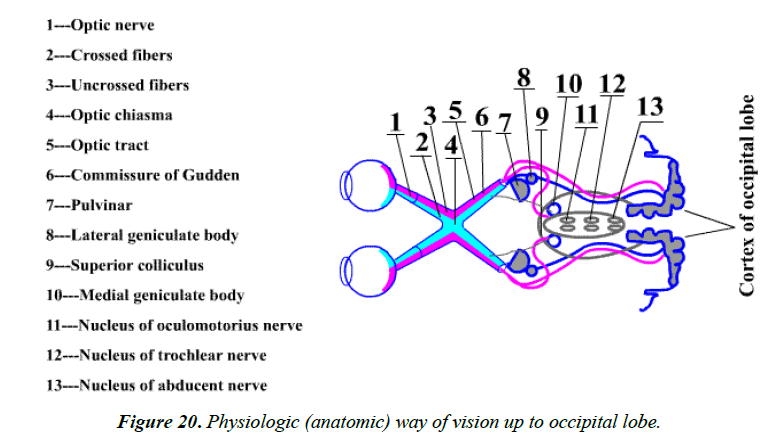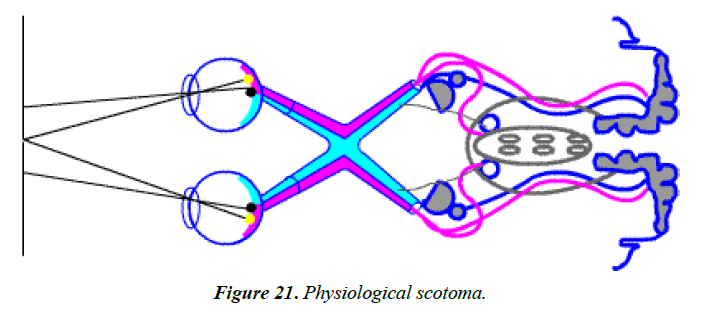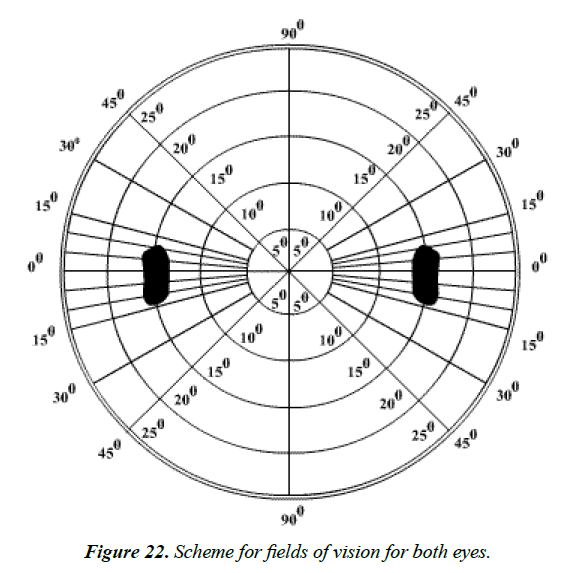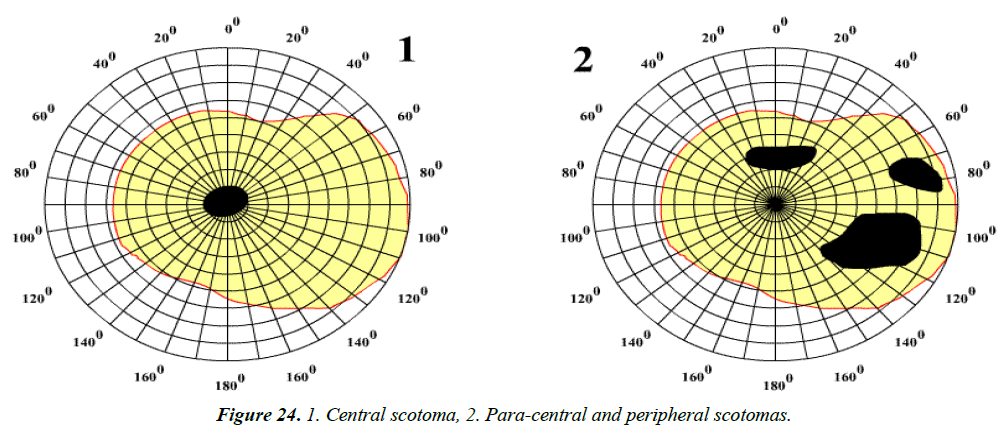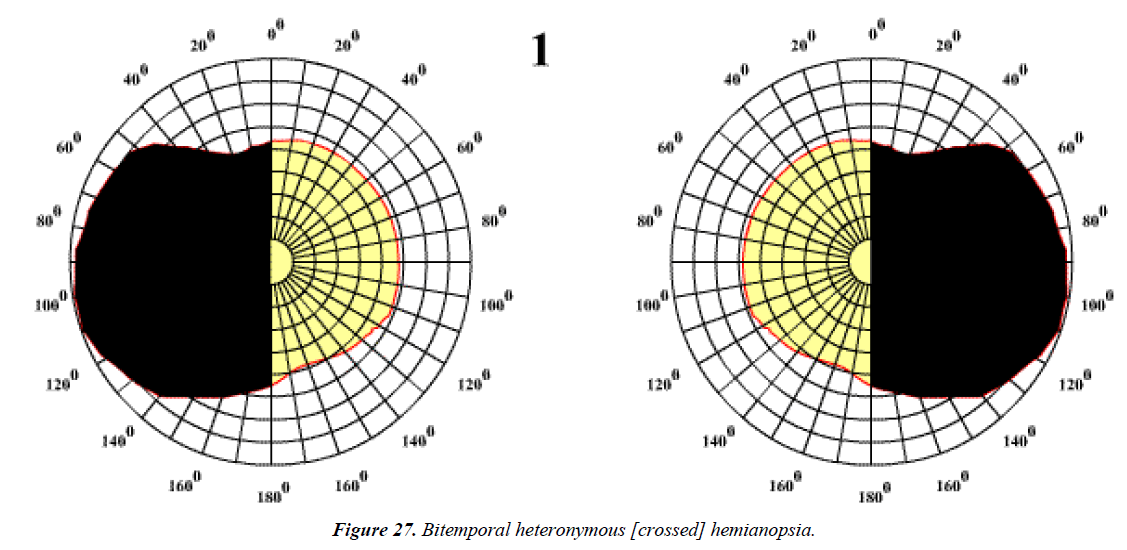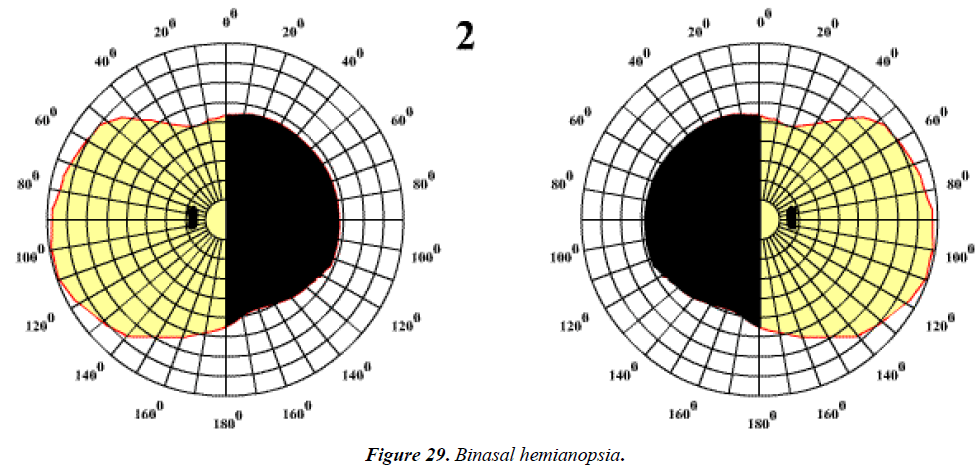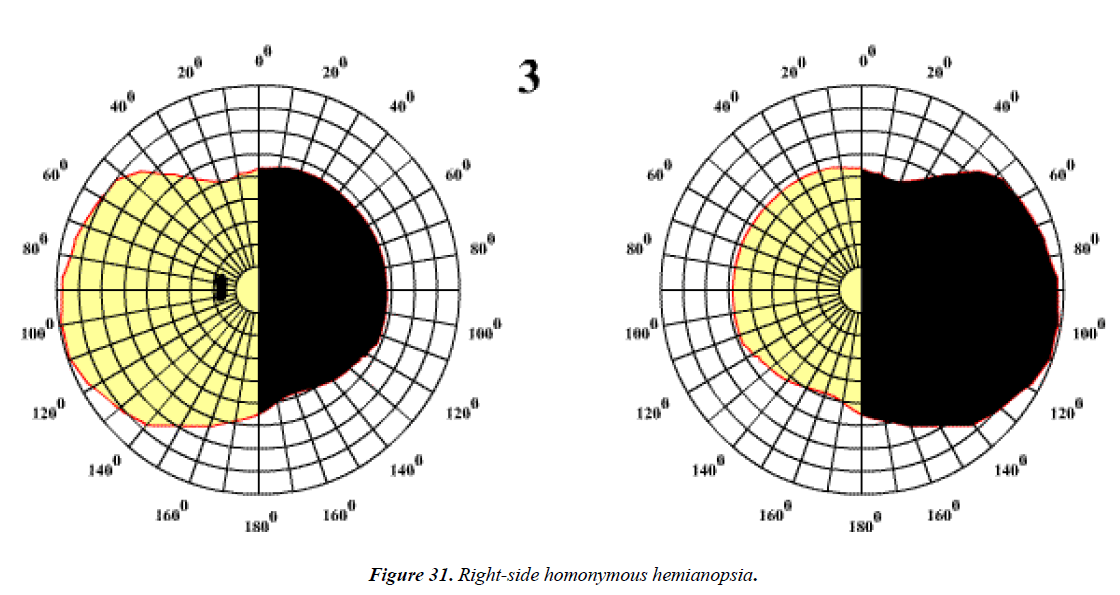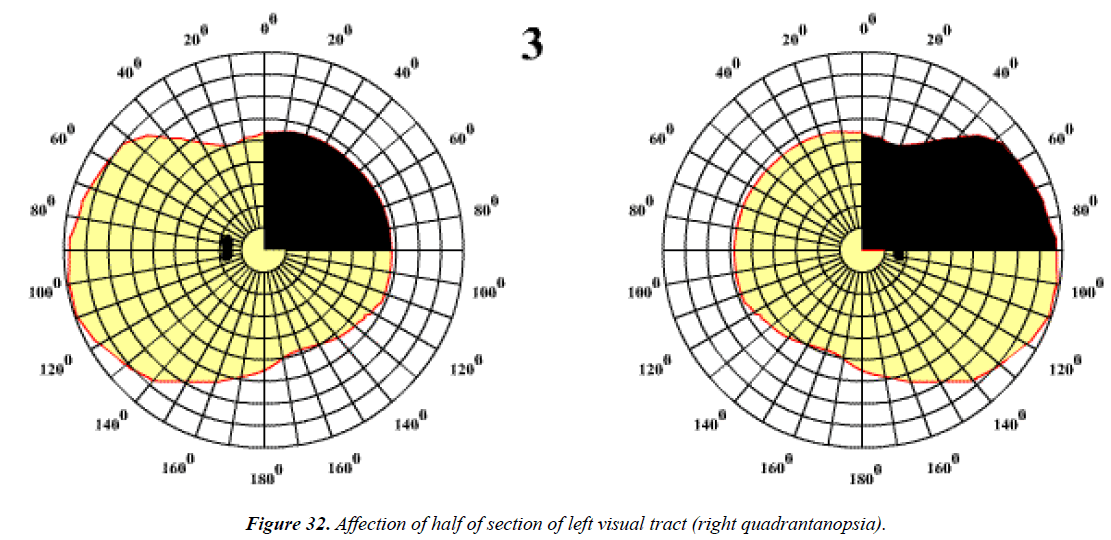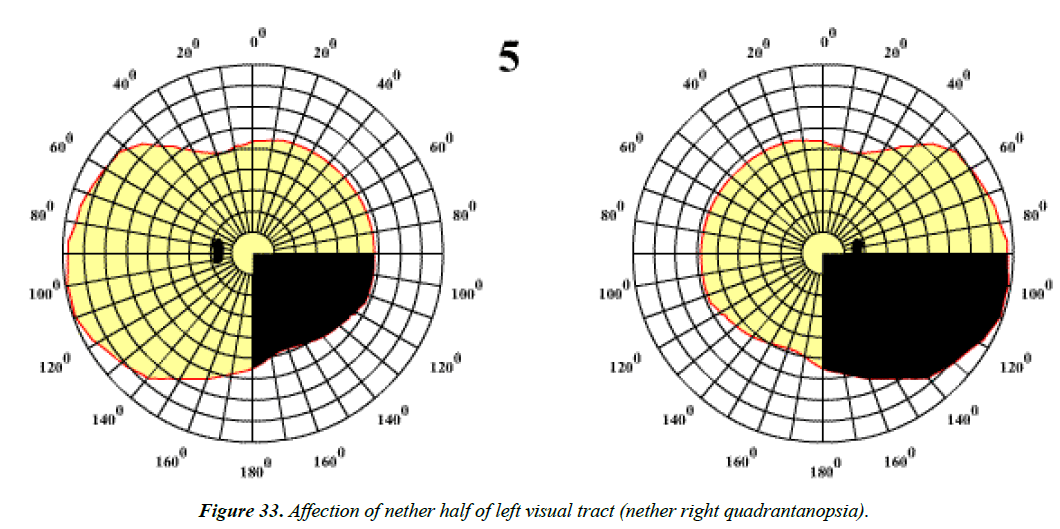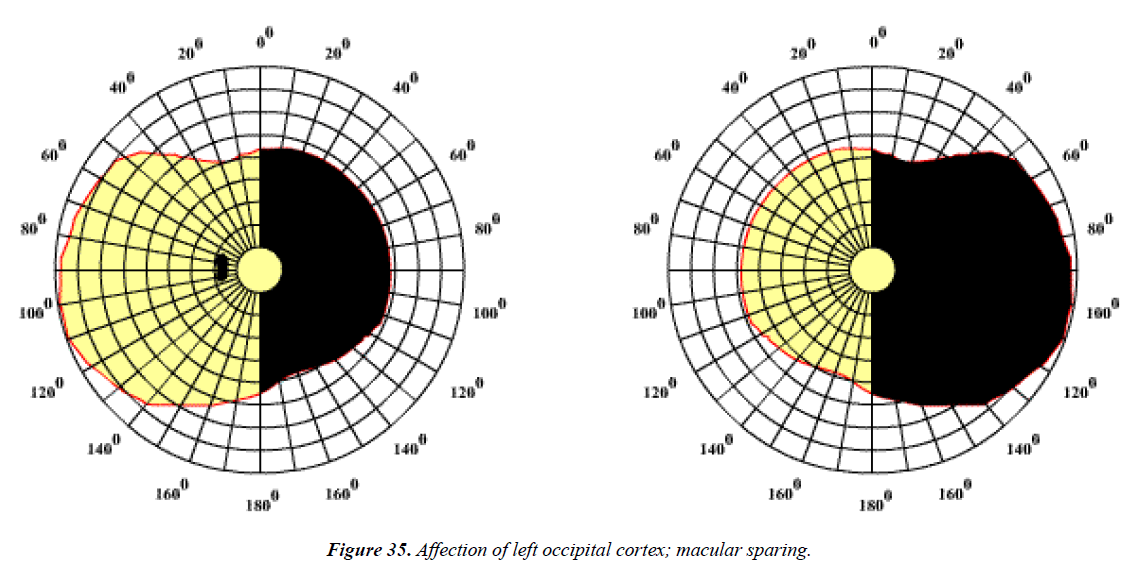Research Article - Ophthalmology Case Reports (2017) Volume 1, Issue 1
Perception of vision up to occipital cortex of brain.
Merab urushadze*
Forensic field officer, ICRC, TBILISI medical academy, Georgia, USA
- *Corresponding Author:
- Merab Urushadze
TBILISI Medical Academy
Georgia
USA
Tel: +995322912484
E-mail: zeroca@msn.com
Accepted date: April 04, 2017
DOI: 10.35841/ophthalmology.1.1.20-39
Visit for more related articles at Ophthalmology Case ReportsAbstract
The main goal of the exploration was to clarify the whole mechanism of visual perception of real object in cerebral cortex: to explain some paradoxes of perception with turning wheel, when the spokes of a wheel seem to turn in opposite direction of wheel?s spinning; or flashing lights reversal, when successive shifting of light seems changing its direction in turn within perceived picture. So the article presents explanation of told above phenomena by analyzing of visual perception at stages of visual path. Each following stage of perception was analyzed step by step. Determination of the form and type of image at each stage was based on schemes of damages at mentioned stages of visual path as it is given in a textbook for students of medical university. Illustrative examples are created in macromedia FLESH MX for the purpose of clear understanding of essence of perception for all categories of audience. The main conclusion was based on anatomic specifity that retinal yellow spots of both eyes are represented in both (left and right parts of) occipital cortex, whereas each occipital cortex contains only "one-side-information" of opposite visual field. Cortical corresponding parts of yellow spots are represented only as frame of reference for the future synthesis of half images in higher cortical systems. At the same time conception of perception in higher visual system was given.
Keywords
occipital cortex, brain, visual path.
Introduction
While sitting outside the local butcher shop, Dustin was staring at the Christmas lights they had around the window. They had them flashing in way that the lights seemed to be moving in one direction; clockwise (I'm sure you see that all the time). As an exercise Dustin dedicated his time there to making the lights move in the opposite direction. It was hard to do at first, but in a while he could look at them and make them go in either direction. I don't know if everyone can do that naturally or not.
This is the matter of perception. I'd like to mention that reading isn't my favorite method; I rarely read scientists' theories, because I think that developing intellectually they blunt the intuition, but I got the book: brief course in psychology. To say the truth, I've never studied it, but as medicine anyway is close to this sphere, everything seemed very interesting to me. I only slightly looked at part perception and as if a coincidence read Dustin's writing [1].
Materials and Methods
I created an animation. I part is developed by me, but the II, and III parts - taken from the course of psychology.
The technique was following: Each entire cycle of animation (one entire turn of each spinning wheel) consists of 20 frames: phases of the starting and ending frames differ from each-other and ciphers show lagging, i.e. different angle between them (each ending phase is turned clockwise at mentioned angle towards the starting one, but starting one is the same for every wheel=stopped wheel). Each cycle afterwards is repeating permanently (to make a permanent picture of revolving), and the option of revolving - clockwise is given to each one, i.e. all wheels are turning clockwise. Enjoy it! And please, concentrate on the variant, when legging equals to 270 degrees, but explanation will be given later (Figure 1).
Here's a new animation: Almost the same one, but difference is that two opposite segments (we can count it one segment) is made red, and I forgot to mention, that speed in both: previous and present one is - 12 frames/sec. This animation was made in order to show visually that all wheels spin clockwise. Anyone can notice shift (jump) from final phase to the starting one, when the ended thorough cycle is beginning anew; it happens because of lagging (the ending phase is turned clockwise at shown angle to starting one), but it doesn't matter in our particular case.
Please, compare two animations: previous and present one: I'd like to explain, why visual effect is, as if some wheels spin counterclockwise
The nether two ranges are final, ending phases of cycle, shown for demonstrative purposes. P.s. I'd like to add, that variant, when lagging equals to 360, is the same as when it equals 0 (Figure 2).
Reading of the part of "brief course of psychology" - perception didn't give me the explanation of considered by us test above (the truth, it gave a lot of interesting explanations of some other phenomena). Anyway, I took first four successive phases of animations (when lagging equals to 0 degrees- I picture, and when the lagging equals to 135 degrees - II picture) and overdrew mentioned four phases for both cases. You can read on the animation the colors of each successive phase:
1. blue, 2.black, 3.red and 4.green; (There are 16 spokes in all within each wheel). You see clearly that in I picture (see separate sector below) the next position! of first blue spoke is marked as black; red spoke is the position of 16-th spoke (the second phase of spinning), its following - green is the position of 15-th spoke (third phase of spinning), i.e. each following position of previous spoke is close to the starting position of next spoke from the left side (in each following position).
As for the II picture , each following position of first blue spoke is disposed close to the position of the second blue spoke (each spoke from previous position takes the next position close to the former position of the next spoke) from the right side (In each following position). I.e. eye constructed the way that it prefers" to perceive closer next disposition - shifting to closer distance despite direction of spinning! I.e. motion is perceived by eye as sum of shiftings between closest distances of spokes' positions. I see that this isn't perfect explanation, but let's continue deeper analysis afterwards (Figure 3).
At the same time I offer a little test for eye. An animation below is the modification of the test from the course of psychology. Enjoy it! Explanation will be given later.
Cover your left eye with hand or simply close it. Concentrate with opened right eye on the bigger black ball, not diverting the attention from it. Simultaneously watch the movement of the small ball with "complementary field of vision". Keep distance of approximately 20-30 cm from the screen. You notice that at some distance small black ball disappears and in a while it appears anew [2].
P.s. You can conduct a test otherwise: with closed right, and opened left eye, but in this case with opened left eye you should concentrate on moving (smaller) ball, observing with "additional field of vision" the bigger black ball. You see clearly, that in a while bigger black ball disappears, and then appears anew in the field of vision (Figure 4).
there are two different kinds of receptors on retina - rod cell and cone cell (of retina) but the place on the retina, where the optic nerve (nervus opticus) comes out, is deprived of receptors, so this point is never irritated by light, so is called "a blind spot" and the part of picture, which falls on this "blind spot” isn’t perceived. The diameter of the “blind spot" is 1.8 mm, but it makes an angle of 6 degrees in the field of vision. When looking binocularly (with both eyes), this defect of vision isn't detected by person, because the field of vision of the second eye covers it. Even with closed one and moving second eye this defect of vision isn't detected, because "a blind spot" is moving, and part of the picture, fallen on it also is moving to another part of retina, i.e. this spot is detectable only with closed one and fixed another eye.
When reading the brief course of psychology (part - attention), I came across one interesting experiment: as it appears, the individual doesn't perceive by vision everything that's in the field of vision (for instance, if we are looking at the blackboard with 20 different numbers written on it, we don't perceive simultaneously all, but only part of them) despite impressing of all of them on the retina. What's the reason? i.e. why all numbers aren't perceived despite them being within the field of vision? It was told in the conclusion that volume of attention is restricted (defined). As experiment revealed, volume of attention usually equals to 5-6 simple impressions. When in the device, called tacho-scope, the persons were shown huge amount of black points with the speed of one/tenth, or one/fourth of second, the persons couldn't perceive more than six ones at the time [3]. (The number of shown simultaneously perceived objects lessens to five, if instead of black points small pictures of numbers are displayed) As a conclusion, the person generally can't perceive all material that's impressed on the retina. The question, why, isn't answered yet, at least I didn't find what is material substrate, ground for such perception in detail. I offer a simple animation, as test for readers: You should concentrate on red point within the circle and test, how many numbers or letters you can read at the same time. I can 4-5 including red point. The technique of animation: there are 40 frames in animation and speed is 4 frames/sec, i.e. the time of appearance of one frame is one fourth part of second. Numbers and red point are placed within the same one frame (Figure 5).
To simplify analysis I changed tactics a little: defined the angle between each following phases (As you remember, in the examples above I defined only starting and ending phases and the animation was created by program automatically). I took the wheel with 16 spoke again, but in this case - regular figure (As you noticed, the distances between animations above weren't equal). The angle between each spoke equals to 22.5 degrees (360/16=22.5). I took one sector, i.e. two neighboring spokes encircled with arc, (the length of arc is L), and divided this sector into two parts by bisector. The length L=2Πr/n, where n is a number of spokes n=natural number. Let's take any point on the circle (for convenience - the point, where radius is touching the circle: green point-a on the diagram D). Let's first consider the variant, when lagging (i.e. the length of arc- L1 from the point a to the next, following location of the same point a in next phase is less than L, i.e. less than arc between neighboring spokes. Let's divide this particular task into three parts: when
1.L1<L/2,
2.L1=L/2,
3.L1>L/2;
In any case when L1<L/2, (angle between two following phases is within the range between 0 and 11.25 degrees) revolving is perceived as clockwise (variant A on the diagram), i.e. any following location of the first spoke in next phase falls left-side from the bisector (in our particular case the lagging equals to 5 degrees, i.e. is less than 11.25 degrees - between the first spoke and bisector - variant A on the diagram). When L/2< L1<L, revolving is perceived as counterclockwise, i.e. any following location of the first spoke in next phase falls right-side from the bisector (in our particular case the lagging equals to 17 degrees, i.e. is less than 22.5 degrees - between the first and second spoke, right-side of the bisector - variant B1 on the diagram). When L1=L/2, revolving is perceived in both directions equally simultaneously, as any following location of the first spoke in next phase falls on the bisector. Let's consider as well the variants, when lagging is more than L (L1>L). So, the final formula can be:
If lagging: K*L+ L1, where K is whole number and L1< L/2, clockwise - Variant A
If lagging: K*L+ L1, where k is whole number and L1> L/2 counterclockwise -Variants B1 and B2.
If lagging: K*L+ L1, where k is whole number and L1= L/2, in both directions, i.e. revolving direction depends on your inclination and on your eye - Variant C.
The following position of the first spoke is marked as thick black on the nether part of diagram, where separate sectors are drawn (Figure 6).
I've forgotten the variant, when lagging L1 equals to L, or rather when L1=K*L and K is a whole number. In this case spinning of spokes isn't perceived (in our case lagging equals to 22.5 degrees between successive phases - clockwise, and spinning of wheel also is clockwise) (Figure 7).
To make more presentable the animation above, I changed it a little (painted in blue one sector of wheel). So, you see clearly, that spinning of spokes isn't perceived, but spinning of wheel – yes (Figure 8) [4].
• Let's clear our tactics: Generally nobody can prove anything to anybody, and can't be sure of 100% correctness of any phenomenon. Even what seems to us outer universe can be a perverted perception of something quite different, i.e. kind of illusion, or dream, but we can be sure that at least one single assertion - "even illusion of existence definitely means existence" is right. So expression - I exist for certain, is sound.
All concepts of mankind bear experimental character, i.e. the character of assumption, but if afterwards this assumption is somehow "proved", then we accept it more or less firmly. For instance, let's take mirror: If I see that face of somebody familiar to me is the same (might be with some distortions) in the mirror as without it, so I can guess how I look like, i.e. the appearance in mirror, when I stay alone before it, is mine, i.e. it's just my appearance. I can strengthen my assumption with additional actions: moving of hand a little gives the same "reply" within mirror; the background in it is the same as real one, so generally I conclude that mirror reflects precisely existing before it. Is it really true or false, it's another matter, so let's eliminate illusions maximally, i.e. Let’s analyze subject, assuming that this world is really what we see, bearing in mind at the same time that all of us perceive it differently and that it might presents an illusion. At this moment we have:
1. All scenarios (pictures) are perceived as a whole and the same element within different pictures are perceived differently (arrows and intervals -a,b, above).
2. Only small part of objects, which are placed within field of vision, are perceived at the time by attention.
3. The most important - direction of movement is perceived by eye as shifting to the closest next position despite direction of movement.
I'm going to recall a little about construction of eye, which I completely forgot. And then add my notion about the motion in universe generally and try to conclude what's the reason for the phenomenon, touched in this thread, so, please, let's not generalize conclusions beforehand.
I revised slightly the construction of eye and found some interesting material below for our need, but couldn't find any explanation for our phenomenon (I chose only interesting for me anatomical and physiological points; will mix them below without systematization yet, and try to be as brief and rough as can, because the more facts and explanations, the more it becomes sour to digest):
1. The influence of light, coming (emanated or reflected from object) is the basis for vision (i.e. no light, no vision of object).
2. Influence of stream of light beam is perceived not directly by cone and rod cells, but through photochemical processes (i.e. light stimulates photochemical processes in cone and rod cells, which afterwards is conducted to cortical centers).
3. Each point of outward object makes separate feeling within elements of retina (for people who isn't familiar with anatomy of eye: retina is the back part of eyeball - the first stage for visual perception; it consists of two different kinds of receptors:
1. cone cells,
2. rod cells; To say roughly, the first - for feeling of color, the second - for feeling of intensity of light only)
3. The quantity of cone cells is maximal within yellow spot (macula lutea) which is gathering of mainly cone cells on the retina (almost central part of the latter, and neighboring mentioned previously "blind spot", where optic nerve comes out on retina) and presents itself a material substrate for "central vision" (see below) [1].
4. Combination, synthesis of these separate feelings afterwards in cerebral occipital cortex makes precise reflection of surfaces with their entire particular feature.
5. Visual analyzer (the way from retina up to central occipital part) consists of three parts:
• Perceptive - retina with its physiological mechanisms.
• Conductive - nervous opticus, chiasma opticus, tractus opticus (see picture below, 1,4,5 respectively).
• Sub-cortical centers - lateral geniculate nucleus, optic radiation, and cortical visual centers (8, and the rest - parts of occipital cortex).
6. The field of vision can be divided into two parts:
-Central (carried out by yellow spot, which presents the gathering of maximal quantity of cone cells) - it's characterized with the ability to distinguish form and small parts of objects;
-Peripheral (carried out mainly by the rest of yellow spot parts of retina, which is characterized with lessening of quantity of cone cells and presents mainly the gathering of rod cells, the quantity of those is gradually lessening peripherally as well) - acuteness of peripheral vision is considerably lower, then of central one, and it serves mainly for orientation in 3D space purposes.
P.s. the picture is taken from Wikipedia (Figure 9).
http://en.wikipedia.org/wiki/Visual_system
Result
The material, collected by me is well-known by each first-year student of med. Institute. I always try to make conclusions by existing obvious information as simply as can, but anyway have to complicate matters. But it doesn't matter: At the end I'll try to systematize all material briefly, if I manage...
Let's conduct a little test (recalling past simplest experience of all of us about remaining trace within field of vision after watching the Sun, or light bulb, or welding, i.e. electric arc with subsequently closed eyes); As the impression of the Sun is too strong and powerful, so I prefer the test with bulb:
When watching the switched-on bulb, open the eyes and close them quickly again several times, concentrating on switched-on bulb, or switch it on/off several times in turn (better in the dark room); finally concentrate on the visual perception within field of your vision with closed eyes (concentrate on the perception, left as a trace) allowing some period of time to pass after eyes' closing [5]. The first, you can notice after final closing of eyes, is that the trace of bulb, i.e. impression of it is lighter, then background, which is darker. After a while (keeping eyes closed) impression of bulb becomes darker to compare with background of impression, i.e. Trace impression becomes inverted!
After eliminating the trace completely within field of vision of closed eye you can repeat the test. I wonder, with which particular part of our visual system we perceive mentioned inversion? As eyes are closed (or rather the bulb as light source, i.e. as stimulant, is turned off), retina isn't irritated by external stimulant! So trace impression (even if it's the result of direct changing of condition of cells of retina) is perceived by either occipital parts of brain, or "higher" cortical systems. I'll try to seek existing valuable explanations, and if I can't find them, I'll have to offer my humble version [2].
Anyway, my early belief is that "flashing light reversal" is somehow connected with time, that's needed for passing of irritation from retina up to higher perceptive cortical centers of brain together with listed physiological mechanisms.
Meanwhile let's revise some material about central vision: As we mentioned, the central vision is conducted by yellow spot and its central part - optic fovea - a pit with a diameter of about 0.2 mm, which presents gathering of maximal quantity of cone cells. At the distance of only 10 degrees from optic fovea acuteness is one/fifth part of central vision. Practically it's very important for oculists to measure acuteness of vision. Under the acuteness the ability of eye to distinguish two separate bright points, placed close to, or maximally distant to each-other is meant. That's to say that acuteness of central vision comes to definition of minimal distance between two bright points, when these points are visible (perceptive) as separate two. If before eye, at some definite distance from it, two bright points a & b are placed, in order to receive image on the retina obligatory is that light beams passed through optical medium of eye, through the focal point of k up to retina. The points a1 and b1 are images of the points a & b on the retina [6]. The angle akb=a1kb1 and is defined as angle of vision.
According to the great amount of research, normal eye of human can perceive two different irritations as separately two ones, when they are disposed at the angle of 1' and this equals as linear measurement of 0.004 mm between images, i.e. two points are perceived as separate ones, when the distance between their images on the retina is 0.004 mm. This value has its ground in anatomical elements of retina within yellow spot: the cell of pigment epithelium with a few neuroelements is independent light-receiving unit. If two images of both bright points are received in the same neuroelement, or neighboring two ones, then they merge into one.
If the images of bright points are received on two neighboring neuroelements, then the sensation of short line is perceived, as both irritations will interflow together and give one sensation. If images of points a & b on the retina are received on the neuroelements, separated by not irritated single one between them, eye will perceive two points separately.
Therefore, in order to perceive two different points as separate two, the distance between images of these points on the retina must be not less than diameter of one single neuroelement (the size of which in humans equals to 0.004 mm, or 1' angle of vision) (Figure 10).
Each eye presents itself independent organ (from physiological point of view) for perception of form (central vision) and orientation in 3D space (field of vision). But ability of human's visual analyzer to define the third dimension - stereoscopy of surrounding objects, is conducted by simultaneous vision with both eyes (binocular vision). I will not stop analyzing binocular vision in detail, only choose essential for me matters.
Apart from the acuteness of vision, correct associative movement of eyeballs towards the fixed object is needed: parallel position of axes of vision of both eyes when looking along, and convergence (convergence is the simultaneous inward movement of both eyes toward each other, usually in an effort to maintain single binocular vision when viewing an object) - when looking at close objects. The central nervous system is the main regulator of muscular balance in order to coincide, join two separate images of both eyes (placed in the central fovea of retina) [3].
Single image (of surveyed by both eyes object) is perceived when images fell on identical - corresponding parts of retina of both eyes. Then received image will be projected on corresponding zones of occipital zones of cortex and the images from both eyes will be perceived as one, i.e. correctly. At the same time I'd like to emphasize that, if each point of outer object is perceived as separate feeling on retina, one irritation, conducted to cortical parts from retina is perceived as well by separate neuron of cortical zone!
Corresponding zones of retina in the first place are the central foveal pits of yellow spots of both eyes and besides them all points, in both eyes situated on similar meridians and at the same distance from central pits. The best method to imagine the corresponding - identical points of retina of both eyes is - eyes, moved to the central point of forehead and placed as if one eye of Cyclop: the internal part of right eye is coincided with lateral part of left eye, and the lateral part of right eye - with internal (medial) part of left eye. Covering each-other the parts of retinas of both eyes are identical, of corresponding points (Figure 11).
Dissimilar, or non-identical points of both eyes are either both internal or both lateral - external parts of eyes (they are disparate points). The images from them are conducted to separate points of cerebral cortex, i.e. are projected in different points of 3D space, i.e. are perceived as separate points and doubling arises. The most important, the binocular vision gives to human, is stereoscopic vision - to see outer world in 3 dimensions.
The basis for stereoscopic vision, and also for determination of distance, is physiological doubling. The perception of third dimension, of depth, of defining distance is result of placing of images on dissimilar, non-identical points of retina, disposed symmetrically towards the yellow points and this gives physiological doubling vision. Fixed point O gives its image on the yellow points - ff of both eyes. If some object G is placed farther from fixed point O, then image of this point is placed medially from yellow points of both eyes (in disparate points - gg) and are projected in space as two separate, different objects - g1g1: right-side with right eye and left-side with the left eye from the objects, disposed farther from fixed point. Result is direct, or uncrossed doubling [4].
The object u, placed nearer to the eyes from the fixed point O gives its image on temporal parts of retina for both eyes (u and u) and are projected in space as two separate objects (u1u1 - crossed physiological doubling). The images of objects, placed beyond the fixed point aren't included in relief in the visional image, as they are placed on the peripheral parts of retina, but at the same time these doubling images serve as reference point for determination of position of object in 3D space. These doubling images serve as reference point for determination of objects in 3D space. This doubling isn't perceived and it doesn't interfere with vision. Neutralization and interpretation of physiological doubling, forming of the whole amount of "visual directness" as well, happens in cerebral cortex. Physiological doubling is inhibited, as if ignored, suppressed. As it doesn't interfere with vision, so is called physiological.
Fix your vision on a tip of your finger, distant from your eyes from 30 cm. At first place a pen between your eyes and your finger, then farther of finger (not taking away your central vision from the tip of finger, simultaneously watching the pen with your peripheral vision.) and you'll perceive physiological doubling by your peripheral vision, i.e. by your field of vision (Figure 12).
The most part of this knowledge has been acquired quickly. My spouse (she's a physician-reanimatologist) supplied me with the book "the diseases of eye"; (for students of med. Inst.), but, apart from diseases, I found some anatomical and physiological parts professionally explained for students in it. I also searched for Wikipedia and found very interesting material about illusions (great part without explanations) there. So, some anatomical and physiological behavior of eye as organ, would be useful for us in future discussions about illusions and future explanations for them [7]. And I've been concentrating on the eye for three weeks and got cleared some aspects for me, but couldn't solve so far the reason, why visual system+brain of human perceives "flashing light reversal" the way, it does. So, let's summarize the themes touched above:
The physiological doubling is of two sorts and there are two sides of one test to check it:
The test for it:
-Crossed physiological doubling
Place your finger at the distance of approximately 30 cm before your eyes and concentrate on the tip of it. Then place the pen nearer to eyes from your finger vertically (between your eyes and finger) and watch it with your peripheral vision (with field of vision), not taking your central vision away from the tip of finger. Then close/open right! eye several times: You see, that left figure of doubling image is appearing/disappearing, i.e. doubling is crossed. (consult the scheme #2 above).
-Uncrossed physiological doubling
Place your finger at the distance of approximately 30 cm before your eyes and concentrate on the tip of it. Then place the pen farther from your finger and watch it with your peripheral, or field of vision, not taking your central vision away from the tip of finger. Then close/open right! eye several times: You see, that right figure of doubling image is appearing/disappearing, i.e. doubling is uncrossed.
Discussion
I'd like to divide motion, which takes place within whole field of vision into two parts:
1. When scenario, background actually is unmoving and you are concentrating on moving object with your central vision (let's say, you're sitting in the room and watching flying fly).
--------In this case you are watching the background with your peripheral vision, i.e. to say figuratively, doubling background is moving in your peripheral part of vision, but your central vision is fixed on moving fly.
2. When scenario, background actually is unmoving and you are concentrating on fixed object with your central vision (let's say, you-re sitting in the room and watching the nail on the wall with your central vision, and are simultaneously watching flying fly with your peripheral vision).
--------In this case you are watching the background with your central vision, i.e. fixed part of background - the nail is in your central vision, doubling background - the room is unmoving and doubling image of fly is moving in your peripheral vision.
3. When scenario, background actually is moving and you are concentrating on either fixed or moving object with your central vision (let's say, you're sitting in moving car and are watching flying within fly with your central vision, simultaneously watching with your peripheral vision unmoving inner part of car and moving street), or you're sitting in the car and watching some "unmoving" (from your frame of reference) part of car, let's say, tape recorder with your central vision, simultaneously watching flying within car fly and actually moving background of car (the street) with your peripheral vision.
--------This variant comes to the second variant...
I.e. all scenario of watching, i.e. the whole field of vision can be divided into two parts:
The part, which falls on central vision (this part can be actually moving from frame of reference of eyes [your eyes are moving as well) or actually stopped (your eyes are stopped]),
The part, which falls on peripheral vision (this part as well consists of actually moving and unmoving parts [and is perceived by your peripheral vision differently: according to action your eyes conduct]).
Anyway, it's interesting what Dustin saw when looking at Christmas light?
I think it was something like this (Figures 13 and 14).
Until considering visual cortical zones and perceptive cortical visual functions, I'd like to mention, that in my opinion, any image, fallen on and then perceived by visual system (from retina up to occipital cortical stages) is result of influence of discrete light (eliminated or reflected from outer object), i.e. light influences on visual system in discrete form. Let's analyze following observation:
After switching the light in the dark room all objects appear immediately, but they disappear at once with switching off the light, i.e. if permanent influence of light on visual system is stopped, then perception by vision also is stopped, i.e. for permanent visual perception of outer world every-instant influence of light on the retina is needed, but to the question: influence - discreet or indiscreet? I'd definitely answer, that discreet.
(Even I believe that any kind of motion in the universe and even whole motion of universe is consecutive succession of all "stopped", instantaneous phases, but this is another theme). But because of speed of light eye can't perceive this discrete influence of light on the retina, i.e. the influence of each phase separately, so it perceives a permanent unmoved image of outer object. To say otherwise, if any animation, film, or motion is succession, consecutive amount of different phases, then stopped image is consecution of the same amount of phases - but of phases of the same picture [8]. So when watching unmoved scenario, one should bear in mind that this perceived unmoved image is every-instant influence of the same image on the visual system. Image of unmoved background is perceived as indiscreet picture by cortex, but any kind of change in this picture (i.e. motion, which is perceived in indiscreet, "smooth" form) presents quick consecutive amount of phases, and visual system isn't able to perceive all phases!
Considered by us the example above, when lagging L1 equaled to L is obvious proof of that. Eye can't perceive motion (despite its actual taking place) until one sector of the wheel isn't colored differently (Figure 15).
As I mentioned above, each point of outward object makes separate feeling(i.e. separate irritation) within elements of retina, and impulse of irritation, sent from this element of retina to occipital visual cortical center, reaches separate element of cortex as if the contours of whole outer object were copied to the occipital cortex, and as we said, each consecutive phase is overlapping on previous one at some intervals of time, and this fragmentation isn't perceived by eye, if the speed of consecution is high!
As a conclusion I'd like to say that until existing on somatic occipital cortex image doesn't change its place, i.e. until other parts of occipital cortex aren't irritated, the perception of motion doesn't take place.
Let's recall a little about films with moving trains, the wheels of which are visible within pictures (from the remnants of these films the animations of wheels above were constructed) Why eye perceives spinning of wheel of train in two different directions? One can't observe this event in real life.
When camera is fixed on a wheel, i.e. wheel is fixed within the frame of film picture (i.e. wheel is spinning, but not moving on the screen, i.e. it remains in the same place of screen), and perceived by eye motion of train is based on moving to opposite direction background (look at animation below), then eye will perceive it as considered above (spinning wheels with fixed centers) (Figure 16).
But if in the same occasion the camera is fixed on a background (which is unmoved within film picture), but train is moving within picture, then turning of wheels will be perceived as in reality (look at animation below). The centers of wheels are not fixed, but are moving along with simultaneous turning. We can't watch mentioned above phenomenon of oppositely moving spokes (Figure 17).
Anyway, the main question: why brain perceives flashing light reversal the way it does remains unanswered yet. Untill analyzing the "higher" visual systems I'd like to revize the material above:
we must differ from each-other:
1. Trace impression within field of vision in case of closed eyes;
2. Inversion of trace impression within field of vision in the same case.
I'll revise previously told by me slightly changing it:
When watching the switched-on bulb, open the eyes and close them quickly again several times, concentrating on switched-on bulb, or switch it on/off several times in turn (better in the dark room); finally concentrate on the visual perception within field of your vision with closed eyes (concentrate on the perception, left as a trace) allowing some period of time to pass after eyes' closing.
The first, you can notice after final closing of eyes, is that the trace of bulb, i.e. impression of it is lighter, then background, which is darker. After a while (keeping eyes closed) impression of bulb becomes darker to compare with background of impression, i.e.Trace impression becomes inverted!
I wonder, with which particular part of our visual system we perceive mentioned inversion? As eyes are closed (or rather the bulb as light source, i.e. as stimulant, is turned off), retina isn't irritated by external stimulant!
So trace impression (even if it's the result of direct changing of condition of cells of retina) is perceived by either occipital parts of brain, or "higher" cortical systems [9].
I repeat that final visual analysis - final visual perception happens in higher cortical zones; Until considering visual cortical zones and perceptive cortical visual functions, I'd like to mention, that in my opinion, any image, fallen on and then perceived by visual system (from retina up to occipital cortical stages!), i.e. not including higher cortical zones of temporal, frontal or other fields! is result of influence of discrete light (eliminated or reflected from outer object), i.e. light influences on visual system in discrete form.
After switching the light in the dark room all objects appear immediately, but they disappear at once with switching off the light, i.e. if permanent influence of light on visual system is stopped, then perception by vision also is stopped, i.e. for permanent visual perception of outer world every-instant influence of light on the retina is needed, but to the question: influence - discreet or indiscreet? I'd definitely answer, that discreet. Inversion of trace impression, as I mentioned, happens in higher visual cortical systems, i.e. If trace impression "belongs" to visual path: retina-occipital centers, then inversion of trace impression belongs to visual path: occipital cortexhigher visual cortex!
Visual cortex is the term applied to both the primary visual cortex (also known as striate cortex or "V1") and upstream visual cortical areas also known as extra-striate cortical areas (V2, V3, V4, V5). The primary visual cortex is anatomically equivalent to Bradman area 17, or BA17. Bradman areas are based on a histological map of the human brain created by Korbinian Bradman.
I'll analyze afterwards, but let's see how the animation above was constructed: Two identical animations (that differ only in phases) were taken (moving to opposite direction) and overlapped on each-other. As you see, the perception of successive "run" of flashing light by visual system only after overlapping is detected.
Two identical animations (that differ only in phases) were taken (moving to opposite direction) and overlapped on each-other. As you see, the perception of successive "run" of flashing light by visual system only after overlapping is detected (Figure 18).
The speed in previous (upper) two animations is 2 frames/sec.,
But in the animation below the speed of overlapped two animations was increased and equals to 12 frames/sec, i.e. difference is only in speed. The final animation is six times faster (Figure 19).
So, you see clearly that "running light" doesn't exist actually, but it's perceived by visual system, and even is perceived as motions in two different (opposite) directions, changing in turn within perceived picture (Figure 20).
Until considering upstream visual cortical areas, also known as extra-striate cortical areas (V2, V3, V4, V5), I'd like to analyze visual perceptions in case of physiological and several pathological processes from retina up to primary visual cortex - Brodman area 17 (occipital area). First I will place image of mentioned path, then - image of physiological scotoma, i.e. confined, bordered defect in the field of vision. As we mentioned above, in normal field of vision always exists scotoma, named as blind spot. This scotoma corresponds to projection of disc of optic nerve: blind spot is situated on temporal side of field of vision, approximately at the angle of 15 degrees from the point of fixation, and is situated so because disc of optic nerve is on nasal side of retina from yellow spot. I'll explain it further (Figures 21 and 22).
Scotoma - confined, bordered defect in the field of vision can be positive and negative, absolute and relative:
1. Absolute scotoma is when in this part of field of vision white and colored objects aren't perceived.
2. Relative scotoma - when white colored objects are perceived less distincty (as gray), but colors of colored objects - less saturated than in normal parts of field of vision.
3. Positive scotoma - defect in the field of vision, which patient sees in form of black (or sometimes colored) spot, which covers the part of viewed object.
4. Negative scotoma - isn't perceived by patient, but can be detected with examination of patients, and negative scotomas are observed mainly in cases of affection of visual tract (visual passes), i.e. by examining of localization of scotoma (localization of them is just interesting for us) we can unmistakably detect, which part of visual pass is affected, i.e. what physiological function particular part of visual pass is responsible for.
The good example of absolute negative scotoma is physiological scotoma, or blind spot (considered by us above - test for eye) [10].
By disposition scotomas are central and peripheral. If the part of retina - corresponding zone to yellow spot is affected, the central vision suffers heavily. The causes of central and peripheral scotomas are various, but mainly the retina is affected (Figure 23).
Here are schemes of some different forms of scotomas (yellow field on the diagram - field of vision; excuse me, but who doesn't know, I'll clarify for them - yellow field is just what patient sees, i.e. black spots below within field of vision are scotomas):
Each diagram is for right eye (Figures 24 and 25).
Diseases, affecting the higher parts of visual path - chiasma, optical tract, sub-cortical ganglions, corresponding areas of occipital convolution, are accompanied with typical changes within field of vision - the half-parts (half-vision) of field of vision are lost, or constriction of field in the form of quadrants are observed.
Cancers of hypophysis, or inflammatory processes of basis cranii affect internal parts of chiasma, i.e. crossed internal fibers (coming out from nasal parts of retinas of both eyes- see red point below), so appears bitemporal heteronymous [crossed] hemianopsia - loss of temporal halfs of fields of vision of both eyes(Figure 26).
Red point - pathological process. Scheme is for both eyes (Figure 27).
Binasal hemianopsia is when affection of chiasma concerns uncrossed fibers, and this type of hemianopsia is extremely rare, as in this case two opposite (symmetric) parts of chiasma must be involved (see images below), for instance calcification of both internal carotid artery at ephippium (Turkish saddle) (Figure 28).
Small black temporal-side spots within field of vision, as you guessed, are physiological scotomas - blind spots (Figure 29).
I'd like to emphasize, that when uncrossed fibers are affected (they are colored in violet on the animation), that means that corresponding zones of retinas of both eyes (colored in violet) aren't affected and receive image of outer object, but this image isn't conducted to higher perceptive centers for final perception (as damage is within visual path), and unaffected retinas' corresponding zones within field of vision are lost.
In case of affection of visual tracts homonymous [(equi) lateral] hemianopsia arises. In case of affection of left visual tract - right half of visual fields of both eyes are lost, but in case of right visual tract - left half of visual fields of both eyes are lost (see images below), i.e. in both cases as crossed (shown as blue) as uncrossed fibers (shown as violet) as well are affected: (Figure 30).
The scheme below is for both eyes and corresponds to right-side homonymous hemianopsia, when left visual tract is affected (first animation above) (Figure 31).
Small black spot within the field of vision of left eye is left blind spot, as you already know, but right-side blind spot is within lost part of field of vision of right eye.
If affection concerns not whole visual tract, but only part (for instance upper or nether half of section of tract, [i.e. when both - crossed and uncrossed fibers are involved), than not half of field of vision, but a fourth part of it is lost. Scheme below corresponds to affection of half of section of left visual tract. It's called quadrantic homonymous hemianopsia, or quadrantanopsia (Figure 32).
As my dear readers guessed, the scheme from previous post corresponds to variant when the nether half of section of left visual tract is affected; but the picture is different, when affection concerns the upper half of section of left visual tract (see below).
I.e. when nether half of left visual tract is affected, then upper quadrants of right visual hemi-fields of both eyes are lost, but when upper half of left visual tract is affected, then nether quadrants of right visual hemi-fields of both eyes are lost (Figure 33).
At the same time I attach my own rough animation of how real image becomes inverted on the retina and then proceeds its way up to LGN (Lateral geniculate nucleus). You see clearly that both retinas, both optic nerves and chiasma as well conduct the whole inverted picture of real object, but as for visual tracts, each of them conducts not whole picture of real object, but only half-part of it: left visual tract - inverted picture of right hemi-fields of both eyes, but right visual tract - inverted picture of left hemi-fields of both eyes. I.e. both retinas, both optic nerves and chiasma as well have inverted, but anyway complete information about the image of outer object, but right visual tract doesn't have any information about the right hemi-fields of both eyes and left visual tract about the left hemi-fields of both eyes (Figure 34).
Is taken for granted that focal point falls on the center of real object, which is filling the whole field of vision...
The optic radiations: Visual way from LGN (lateral geniculate nucleus) up to occipital cortex (i.e. up to so called "primary visual cortex"): This way consists of two main paths: nether part - so called Meyer's loop, and upper - parietal part. Affection of both or any of them is exactly the same as in case of affection of visual tract:
I.e. if left Meyer's loop is affected, right upper quadrantanopsia happens, i.e. loss of right upper quadrants of visual fields of both eyes.
But in case of affection of left upper (parietal part) of the path, right nether quadrantanopsia happens - i.e. loss of right nether quadrants of visual fields of both eyes.
The most interesting, I'd like to attract your attention, is affection of any occipital cortex. First I'll place a scheme of it and then the explanation (Figure 35).
Before explanation of the scheme from previous post, I'd like to place a little animation of my own: falling of image of moving object on different stages of visual path:
1. Stage A - real red arrow, which is turning clockwise.
2. Stage B - falling of inverted turning images on the retinas of both eyes (as you notice, the animation is made so, as if you were observing the whole visual way from behind of occipital cortex and all this way were transparent).
3. Stage C - turning of inverted image at chiasma (you see clearly, that images from both retinas are coincided in a single one).
--- I specially missed the stage of both optic nerves, because it's exactly the same as those at both retinas.
4. Stage E, F - I'd like to repeat again that each optic tract up to stage of occipital cortex contains the information of half hemifield only: the right part - from left hemi-field, but left part - from right hemi-field, and "information" presents itself inverted image (or part of inverted image) of real object (and ciphers show it).
5. Stage G -Occipital cortex. I'll analyze, what happens there later (Figure 36).
Let's go back to the scheme that corresponds to the affection of left occipital cortex (of the whole left part), which results in loss of right hemi-field of vision. But as you noticed, the macular part (macula lutea is yellow spot, i.e. central retinal part of vision) is spared (macular sparing - this phenomenon is called). The only logical explanation is that each yellow spot of each retina (of each eye) is represented in both occipital parts (e.g. left yellow spot is represented as in right as in left occipital parts of cortex as well, so after affection of any occipital (let's say left) cortex (i.e. when macular part of left cortex is damaged), anyway both macular parts of right occipital cortex, remaining intact, gives the picture of macular sparing for both eyes).
As you remember, the affection of any part of visual path up to the cortex (optic tract, LGN, optic radiation) resulted in complete loss of opposite hemi-field without macular sparing, so that means that some macular fibers (maybe half) from any (let's say left) visual path branch out from optic radiation and get across to another occipital cortex (in our case - to right) somewhere close to occipital cortex. I wouldn't like to argue about the anatomical matters (i.e. about the exact place of branching out of macular fibers for another occipital part), but all scientists miss the question why it happens, what is the reason that both yellow spots are represented in both occipital cortex, whereas each occipital cortex contains only "one-sideinformation" of visual field?
Before continuing further analysis, I can say definitely that final analysis of whole picture of motion doesn't happen in occipital cortex (as each part of occipital cortex contains only "one-side-information" of visual field), but definitely happens in higher visual cortical centers, as two "one-sideinformation" - half-fields (half-images), placed at some distance from each-other need synthesis (see animation - stage G). And representation of both yellow spots in both occipital cortexes is clear: that serves as reference points for future synthesis of half-images, i.e. exact points, at which half-images must join for synthesis [11].
The final picture, up to the stage of occipital cortex, needed for me, is ready. The macular paths from both yellow spots up to both occipital cortexes are made different in color for demonstrative purposes only (see animation below): Until trying to make out what exactly happens in higher visual cortex (up from occipital cortex, and believe me I've never studied it) I'd ask myself: If I had to make the apparatus of perception and had the situation exactly the same we have, how I'd try to join these half inverted images for correct perception of real moving object? There's a lot of way for that, but My preconceived answer is: I'd try to invert back these half-images towards the macular point (as a frame of reference), then would move across to opposite parts of brain again (from left occipital cortex to right higher cortex; from right occipital cortex to left higher one), but would choose not distanced parts of higher cortex (for instance I'd choose two adjacent parts of frontal lobes of both hemi-spheres of brain in order not to distort the final synthesis of half-images in the process of joining [i.e. would eliminate maximally possibility of distortion, caused by anatomical distance]) and the most important - I'd first define the point of reference for joining of half-images (and would surely choose for it macular point [i.e. equivalent spot of higher cortex for macular point], towards which I'd calibrate the whole path and the whole process of synthesis). O.K., let's stop dreaming and check, is there any somatic capability of brain for that?
Let's go back to the scheme that corresponds to the affection of left occipital cortex (of the whole left part), which results in loss of right hemi-field of vision. But as you noticed, the macular part (macula lutea is yellow spot, i.e. central retinal part of vision) is spared (macular sparing - this phenomenon is called). The only logical explanation is that each yellow spot of each retina (of each eye) is represented in both occipital parts (e.g. left yellow spot is represented as in right as in left occipital parts of cortex as well, so after affection of any occipital (let's say left) cortex (i.e. when macular part of left cortex is damaged), anyway both macular parts of right occipital cortex, remaining intact, gives the picture of macular sparing for both eyes).
As you remember, the affection of any part of visual path up to the cortex (optic tract, LGN, optic radiation) resulted in complete loss of opposite hemi-field without macular sparing, so that means that some macular fibers (maybe half) from any (let's say left) visual path branch out from optic radiation and get across to another occipital cortex (in our case - to right) somewhere close to occipital cortex. I wouldn't like to argue about the anatomical matters (i.e. about the exact place of branching out of macular fibers for another occipital part), but all scientists miss the question why it happens, what is the reason that both yellow spots are represented in both occipital cortex, whereas each occipital cortex contains only "one-sideinformation" of visual field?
Before continuing further analysis, I can say definitely that final analysis of whole picture of motion doesn't happen in occipital cortex (as each part of occipital cortex contains only "one-side-information" of visual field), but definitely happens in higher visual cortical centers, as two "one-sideinformation" - half-fields (half-images), placed at some distance from each-other need synthesis (see animation - stage G). And representation of both yellow spots in both occipital cortexes is clear: that serves as reference points for future synthesis of half-images, i.e. exact points, at which half-images must join for synthesis.
Conclusion
The final picture, up to the stage of occipital cortex, needed for me, is ready. The macular paths from both yellow spots up to both occipital cortexes are made different in color for demonstrative purposes only (see animation below): Until trying to make out what exactly happens in higher visual cortex (up from occipital cortex, and believe me I've never studied it) I'd ask myself: If I had to make the apparatus of perception and had the situation exactly the same we have, how I'd try to join these half inverted images for correct perception of real moving object? There's a lot of way for that, but My preconceived answer is: I'd try to invert back these half-images towards the macular point (as a frame of reference), then would move across to opposite parts of brain again (from left occipital cortex to right higher cortex; from right occipital cortex to left higher one), but would choose not distanced parts of higher cortex (for instance I'd choose two adjacent parts of frontal lobes of both hemi-spheres of brain in order not to distort the final synthesis of half-images in the process of joining [i.e. would eliminate maximally possibility of distortion, caused by anatomical distance]) and the most important - I'd first define the point of reference for joining of half-images (and would surely choose for it macular point [i.e. equivalent spot of higher cortex for macular point], towards which I'd calibrate the whole path and the whole process of synthesis). O.K., let's stop dreaming and check, is there any somatic capability of brain for that (Figure 37).
References
- Natishvili A. Human Normal Anatomy. Publisher Ganatleba; 1965.
- Sinel'nikov RD. Atlas of Human Anatomy: In Three Volumes. The Science of Bones, Joints, Ligaments and Muscles. Mir Publishers; 1988.
- Arkhangelski V. Eye diseases. Publishing house Meditsina. Moscow; 1969.
- Baudouin C, Garcher C, Haouat N, et al. Expression of inflammatory membrane markers by conjunctival cells in chronically treated patients with glauc. Ophth. 1994;101(3):454-60.
- Guenoun J, Baudouin C, Rat P, et al. In Vitro Study of Inflammatory Potential and Toxicity Profile of Latanoprost; Travoprost; and Bimatoprost in Conjunctiva-Derived Epithelial Cells. Invest Ophth Vis Sci 2004;5: 2444-50.
- Nelson J. Impression cytology. Cornea. 2004;7:71-81.
- Tole D, McKelvie P, Daniell M. Reliability of impression cytology for the diagnosis of ocular surface squamous neoplasia employing the Biopore membrane. Br J Ophthalmol 2008;5:154-58.
- Cajucom U, Tong L, Wong T, et al. The prevalence of and risk factors for pterygium in an urban Malay population: the Singapore Malay Eye Study (SiMES). Br J Ophth 2010;94:977-81.
- Droutsas K, Sekundo W. Epidemiology of pterygium. A review. Ophth 2009;107(6):112-22.
- Liu L, Wu J, Geng J, et al. Geographical prevalence and risk factors for pterygium: a systematic review and meta-analysis. BMJ Open 2013;3:e003787.
- Mahar P, Manzar N. Pterygium recurrence related to its size and corneal involvement .J Coll Physicians Surg Pak 2013; 23:120-23.
